It Started as the Mountain Bike She Couldn’t Afford, But Promptly Became Part of Her Family
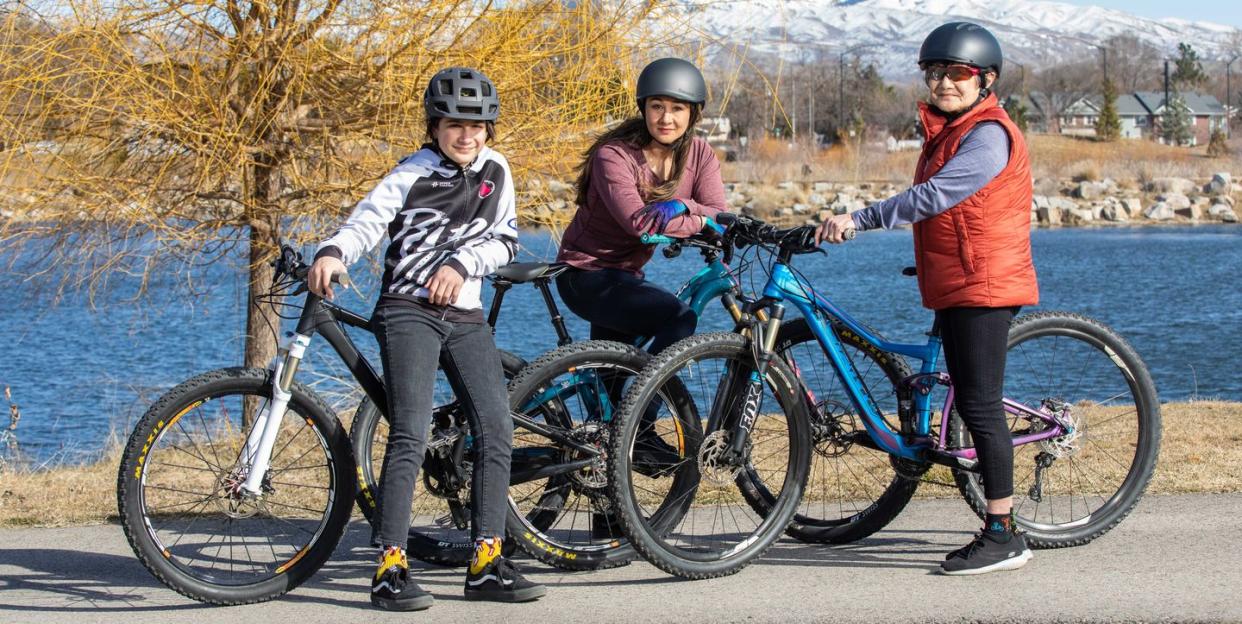
“Hearst Magazines and Verizon Media may earn commission or revenue on some items through the links below.”
It was demo day at the local trail and the trees were dripping with rain. I arrived with a raincoat and a credit card. Thunder rumbled as I traded my driver’s license for a test ride.
The demo guy screwed my pedals onto a Giant Anthem X W, a women’s cross-country bike with 26-inch wheels. For a full-suspension aluminum rig with a triple chainring and 9-speed cassette, this bike was light—around 24 pounds—but I didn’t understand that. My lexicon was missing words like “drivetrain” and “components.” The paint, a silver and seafoam green, reminded me of an ocean fish, and the white fork gleamed. I didn’t know what geometry meant. I just knew this bike looked fast.
I set off on Mr. Toad’s Wild Ride, a spaghetti-like beginner trail I’d ridden—badly—so many times that each wheel-stalling root, overcooked turn, and handlebar-grabbing tree had become a splinter lodged in my confidence.
I was used to a hardtail, one size too large, with tires I inflated (on advice from a dude) to a rigid 60 psi. Rock gardens jarred my vision blurry, and every turn felt like ice. I blamed my bike-handling skills.
The Anthem floated over roots that usually rattled the fillings near out of my teeth. Even in peanut-buttery mud, off-camber turns carved like berms. Within my first quarter-mile on the Anthem, I felt that fluttery thing in your chest that signals you’re in love.
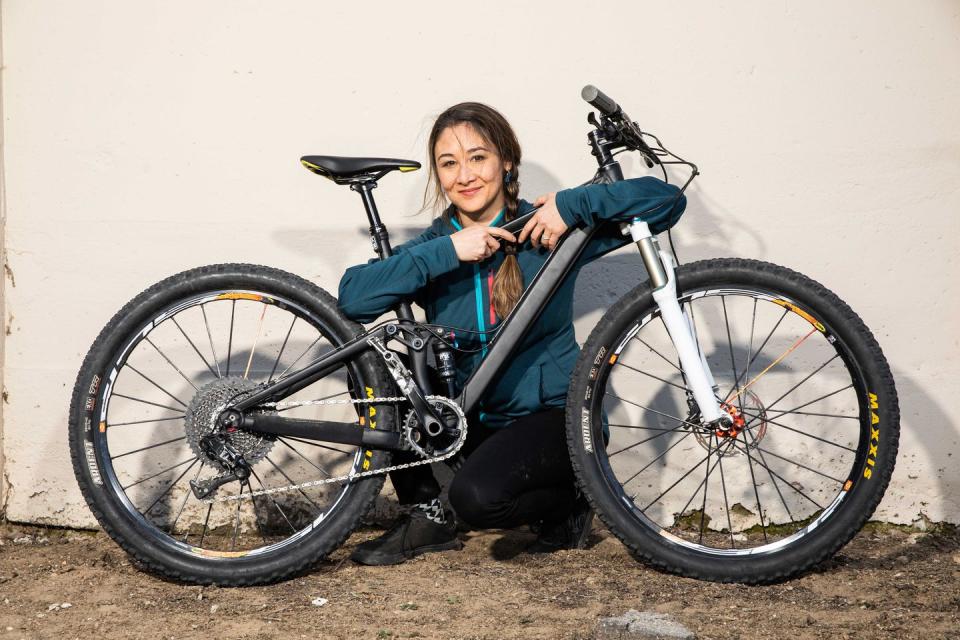
I couldn’t really afford this bike, more than twice the price of my hardtail. I plunked down my credit card anyway. Sold the hardtail. My husband and mom paid off my bike debt as a birthday gift.
It wouldn’t be true to say that the Anthem made me a better rider overnight. It happened instantly, there on that trail, as if by some sort of spell.
I didn’t know then how this bike would shape my future. How it would turn into a vehicle for so much more than a ride. How it would carry three generations to places we never imagined.
It was just a bike. My first great bike.
And it made me really happy.

The right bike changes everything.
Familiar trails transmogrified beneath the Anthem’s wheels. A steep and chunky two-mile climb mysteriously slackened, as if the grade had been dialed down like the incline on a treadmill. Rocky roads melted into vanilla ice cream, like they’d been groomed by some dirt-loving snowcat. Obstacles shrank as my confidence grew. I aimed for the very rocks and logs I previously avoided.
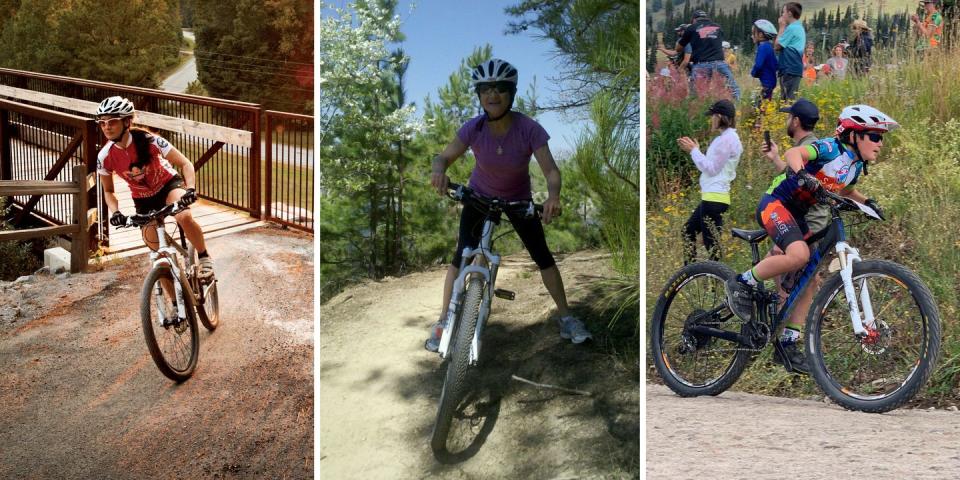
I was a new mother, and the Anthem became my escape pod. Finally competent enough to ride alone, I found solace in the solitude.
BECOME A BICYCLING MEMBER NOW FOR MORE GREAT STORIES LIKE THIS!
Then the bike became a mobile gym for shedding the baby weight. I hooked a trailer to the Anthem and towed my son up hills, spinning in the triple chainring’s granniest gear. The baby napped, my quads burned, and distant goals drew closer.
Next, the Anthem morphed into a vehicle for redemption. Before having my son, I’d entered—and failed to finish—three adventure races. These grueling multisport sufferfests, lasting from 12 to 24 hours, taught me the value (and price) of endurance. I begged my husband, an Eco-Challenge veteran, to help me cobble together a team and cross one lousy finish line.
We finished a 12-hour race—in fourth—and found ourselves unwittingly qualified for the national championships. It went badly. We persisted. Sometime around midnight, cold and seven miles off course, we pushed our bikes through a moonlit field, encircled by snarling dogs. In the 30th hour of that 24-hour race, I carried the Anthem through shin-deep mud, crying and laughing deliriously in a fugue of sleep deprivation. After dawn, we crossed the finish line in some place other than last.
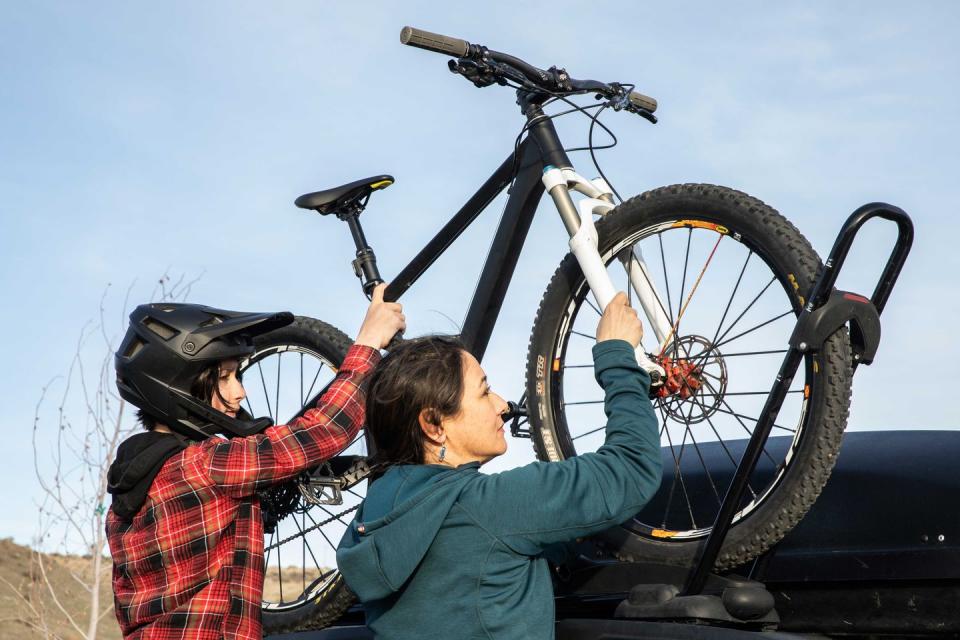
As the baby grew into a toddler, we started racing cyclocross. Unwilling to invest in a ’cross bike, I spent my first season heaving the Anthem over barriers and monster-trucking through mud pits. Our toddler assisted the Beer Fairy—a tutu-wearing, smack-talking, beer-offering mascot—by picking up empty Solo cups. He charged through the kids’ course with a race face worthy of Paris–Roubaix, earning shiny plastic trophy cups smaller than a shot glass.
Cyclocross whipped my lungs, my legs, and (thanks to the 24-pound Anthem) my arms into unprecedented shape. Emboldened by this fighting trim, I started racing off-road triathlons. I endured the swim, dreaded the run, and biked like a woman with her hair on fire trying to put it out with wind. In another moment my pre-Anthem self could never have foreseen, I was invited to race for Team USA at ITU Cross Triathlon World Championships.
The Anthem needed an upgrade.
My husband sourced hand-me-down parts and masterminded the overhaul, which probably shaved a pound or so off the already pretty light bike. We swapped the triple chainring for a double, which powered a newer drivetrain. We added hydraulic brakes and lighter wheels, each with a single red spoke.
My husband made Team USA too. We spent months training harder than ever—running, swimming, and biking twice a day, seven days a week—with a coach and an escalating food bill. The event that year was held in our hometown, on trails we knew by heart. We stepped up to the starting line expecting the race of our lives.
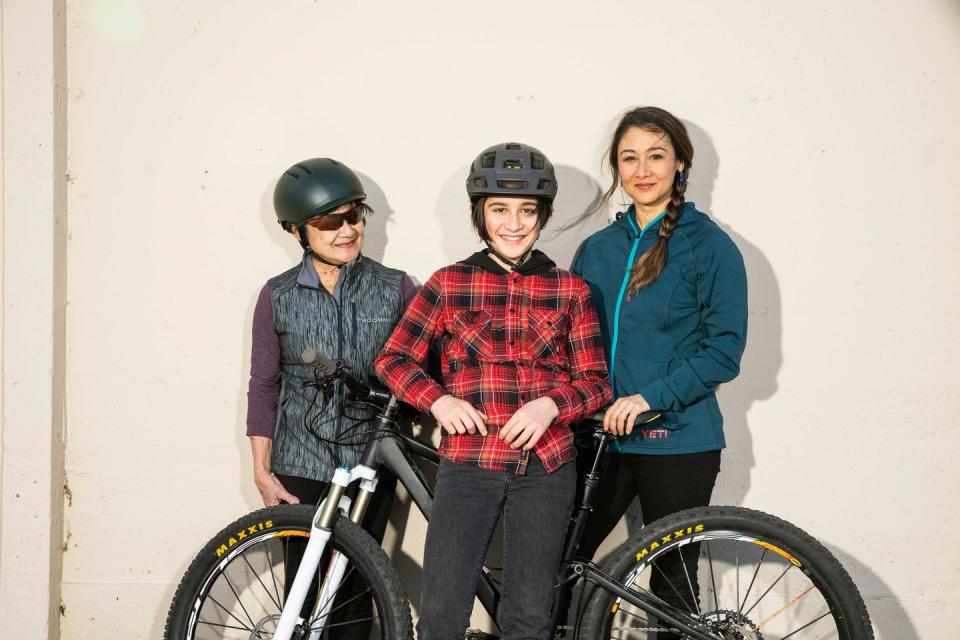
It was, but not in the way we’d anticipated. Race-day nervous stomach turned out to be a touch of the flu. My husband finished far short of his goal.
When it was over, I fought the urge to hide my tears from my now 5-year-old. He needed to see them, to see me fail, to know that failure is part of this. At home, he presented me with one of his kids-race trophies.
“Even though you didn’t win, I want you to have this,” he said. “’Cause I’m still proud of you.”

The first bikes with 29-inch wheels had been on the market for several years. None of them, on a small-size frame, felt better to me than the Anthem. But when 27.5-inch wheels arrived, I developed a wandering eye.
My mother had learned to mountain bike at the age of 69, the only grandma in a women’s clinic I had coached three years before. She owned a sweet mountain bike of her own, but she offered to buy the Anthem. It would help me afford my next one, which, in the natural order of bikes, cost twice what I paid for the Anthem. And there was something special about this old bike, a ticket to so many milestones. It ought to stay in the family.
The Anthem became Mom’s “race car,” even though she felt more comfortable on her heavier, squishier bike, which she lovingly called “my Cadillac.” It was fun riding side by side with the bike that had carried me so far. It still caused a little flutter in my chest.

Meanwhile, in what seems like a time-lapse movie, my little boy grew into (and out of) a series of bikes, each fancier than the last. His balance bike, a potty-training prize, was replaced by a hand-me-down pedal-bike with coaster brakes and 12-inch wheels. The third one, with hand brakes and 16-inch wheels, he had to earn. He “paid” by presenting the bike shop owner a painstakingly handwritten list of 20 chores he did all by himself.
The next one was a mountain bike with front shocks and 24-inch wheels. And then a 20-inch BMX that saw him through his first real race. Competitions began with the national anthem as riders paraded around the track. As the littlest one, sometimes he got to carry the flag.
My boy won some races. Others he lost. He eventually lost count of both. But the ups and downs, like the track itself, taught him things about racing—and living. How to look ahead. How to tuck and roll. How to crash and quickly get back up and finish the job without tears.
The Anthem waited silently in a corner of his grandma’s garage.
One day the boy dragged it out. He was too short to swing a leg over. When we lifted him into the saddle, his feet didn’t reach the pedals.
Then, one day, they did.

He was 11 years old. Fifth grade. A year away from racing on his middle-school mountain bike team. With the saddle nearly touching the top tube, the Anthem fit, sort of.
Mom traded it back in exchange for a titanium road bike, a used beauty I’d bought for $500. The silvery frame matched the metal screws in her arm from a mountain-bike crash at age 72. Set up on a trainer in her living room, the road bike sat, like art, while her Cadillac cruised the trails.
The Anthem went to her grandson.
He didn’t care that it was a women’s bike, or that it had been his grandma’s. It was lighter and faster and better than any other bike he’d owned.
“We need to make it his,” my husband said.
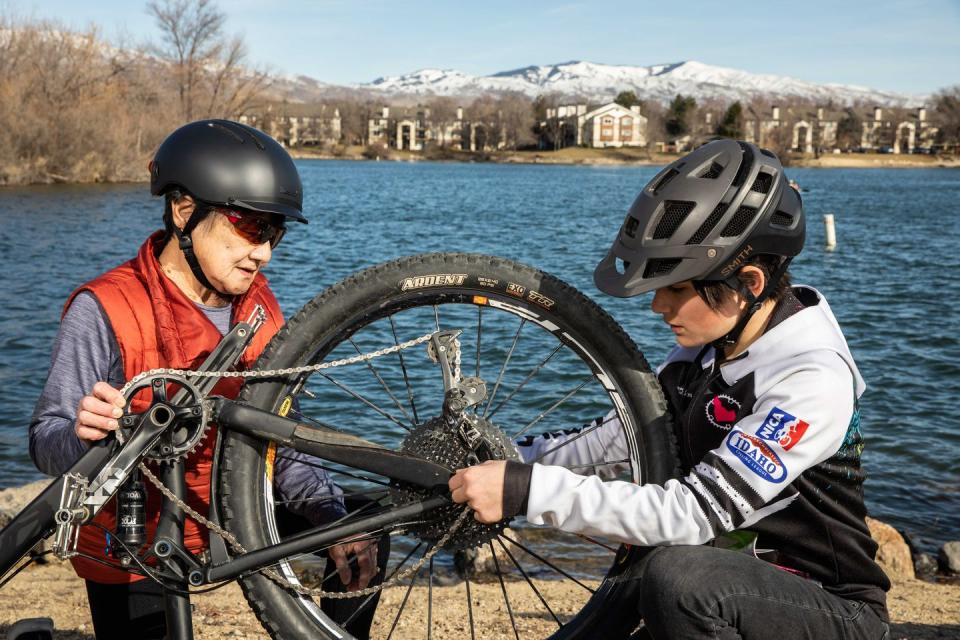
Together they took it apart piece by piece and rebuilt it with shiny new parts. The reinvention began with the silver-green frame. Wearing nine years of dings and scuffs, it needed fresh paint. My son chose to powder-coat it matte black. They replaced the rear shock with a newer one and rebuilt the fork, still a gleaming white but tattooed with battle scars. They upgraded the brakes and converted the double chainring to a single that powered an 11-gear cassette. They bought a sleeker saddle and a carbon-fiber handlebar. They agonized over choosing the perfect tires and converted the wheels to tubeless.
The final touch—the boy’s choice—was a royal blue Giant sticker kit to replace the covered-up logo. The stickers had just a bit of shine, a subtle contrast with the matte black frame. The reincarnation was complete.
My son was 12 when he wheeled the Anthem to the starting line of his first big race—a time trial. The race director handed the mic to my husband, the league director. Even through the buzz of the speakers, I could hear the catch in his voice as he counted down the seconds.
“Five…four…three…two…one…”
The Anthem, by now, was a decade old, which in mountain-bike years means ancient. But it ripped down the trail and tore up hills. It passed bike after bike with carbon-fiber frames and dropper posts and 29-inch wheels. With my boy in the cockpit, it flew again.
The last stretch before the finish line was a painfully steep grassy hill. Some kids got off and pushed. The chute was a ruckus of coaches, teams, and camera-phone-wielding parents. I was one of them.
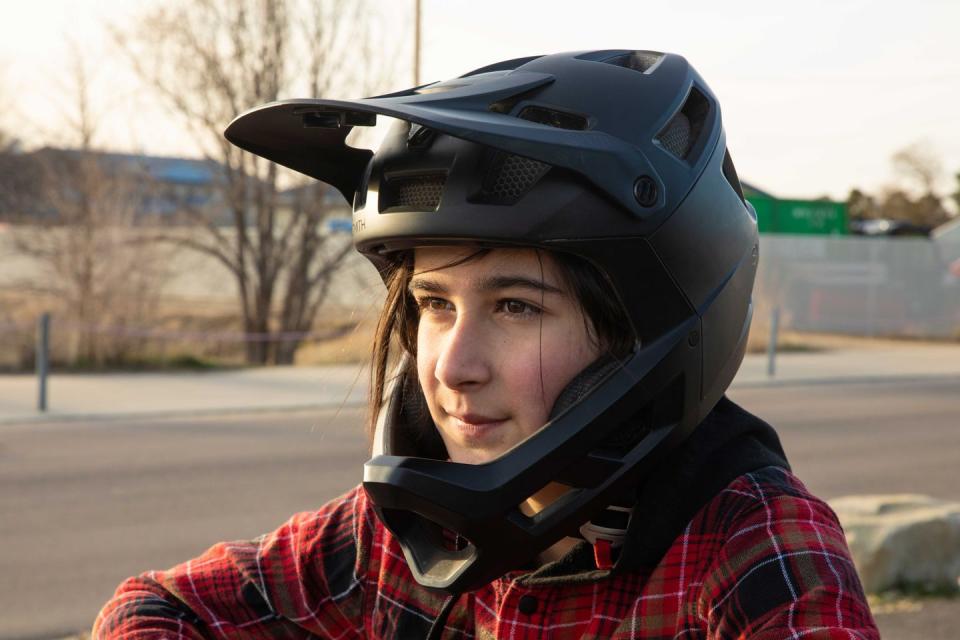
My son was small for his age, and shy. But on the bike, a quiet intensity emerged. He attacked the hill in a standing climb, pumping the bars from side to side. So fierce. My heart nearly burst with vicarious joy—and pain.
He crossed the finish line with a sixth-place time. One spot shy of the podium.
The next race, he finished fourth. At the awards ceremony, he stepped shyly onto the podium, where my husband, hiding tears behind sunglasses, placed a medal around his neck. The boy raised his hands to the sky.

Last year the bike turned 11 years old and my son became a teenager. He built Adirondack chairs and planter boxes to earn a faster race bike. He chose a Scott Scale, a 24-pound hardtail with 29-inch wheels and a fork with a remote lock-out.
The Anthem, though, wasn’t done.
We sawed off the seat post and slammed the saddle all the way down. My son and I bought full-face helmets and spent hours together at the bike park, learning how to ride dirt jumps, wall rides, and scary wooden ramps. We practiced wheelies in our neighborhood and manuals at the pump track.
One day my son looked at the Anthem and said, “You know, Mom, that geometry looks a lot like a slopestyle bike.”
It isn’t, of course. It’s an old cross-country bike that has become whatever we needed.
It reminds me of The Giving Tree, a children’s book that slays me. The tree gives her boy a place to climb and leaves to weave into a crown. When he needs money, she says, “Take my apples, Boy, and sell them in the city.” When he needs a house, she offers her branches for lumber. He grows old and sad and longs to sail away. “Cut down my trunk,” she says, “and make a boat.”
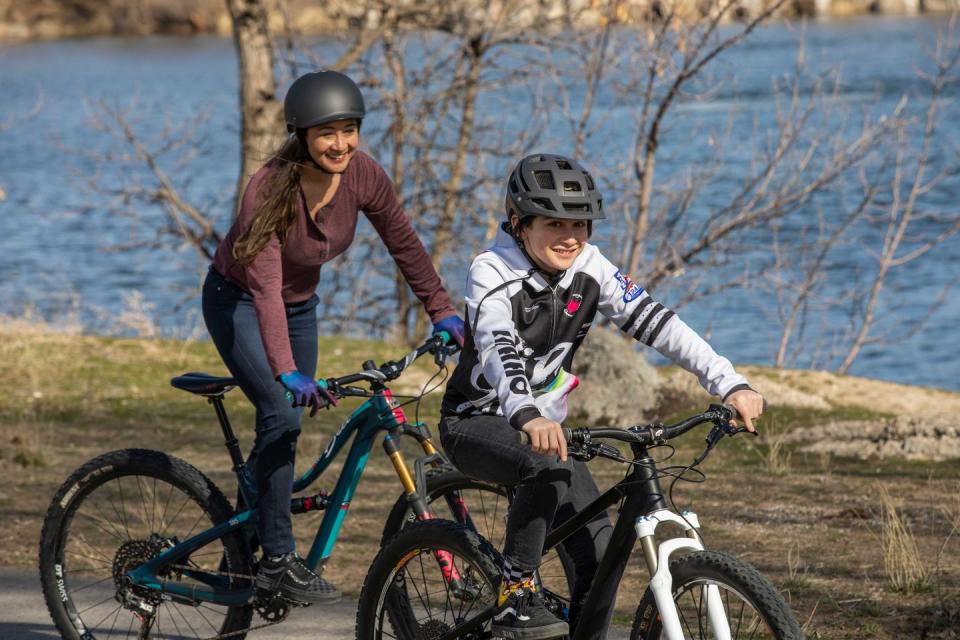
We looked into the possibility of turning the Anthem into a slopestyle bike. Maybe there was some newfangled fork that would slacken the head-tube angle. Maybe we could pump the rear shock to the max to stiffen the back end. Maybe this 11-year-old bike could keep flying in new ways.
Some mechanics thought it was possible, but others warned of the dangers. Under the force of big jumps and hard landings, this bike could fail. Someone could get really hurt.
“If you start bombing on that bike, you’ll outride it,” said a friend, a former pro team mechanic. “I think it’s a bad idea. Sorry.”
My son and I bought dirt jumpers.
Maybe the Anthem had finally reached the end of its winding road. According to Bicycle Blue Book, it was worth around $450. Maybe, our friend suggested, we should donate it. It could be some kid’s first bike.
The Giving Tree is nothing more than a stump when the boy comes back to see her. He is old and tired. The tree is sad to tell him she has nothing left to give.
“I am just an old stump,” she says. “I am sorry…”
“I don’t need very much now,” he says. “Just a quiet place to sit and rest.”
We can’t bring ourselves to give it up, this bike that keeps on giving.
We bought a spare rear wheel with a racing slick and set it up on a trainer. It carried us through an Idaho winter, through the loneliness of quarantine.
It’s been years since my son has seen his best friend, who now lives in a different time zone. One day, the boys logged into Zwift and my son got back on the Anthem. In the land of pixels, side by side and 2,000 miles apart, they pedaled together again.

You Might Also Like

